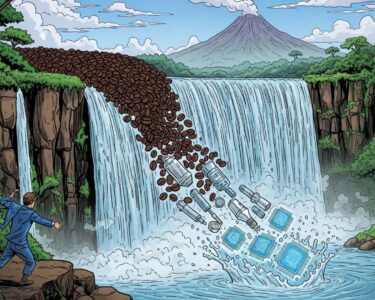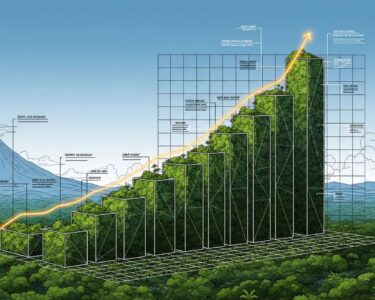San José, Costa Rica — SAN JOSÉ – Costa Rica’s economy showcased robust dynamism in August, posting a year-over-year growth of 4.8%, yet a closer look at the nation’s industrial engine reveals a troubling divergence. New data from the Central Bank of Costa Rica (BCCR) highlights a “two-speed” manufacturing sector, where a booming special free-zone regime, fueled by medical device exports, is masking a significant contraction in traditional domestic industries.
The overall national economic picture, according to the Monthly Economic Activity Index, appears decidedly positive. The 4.8% growth in August represents an acceleration of 0.8 percentage points compared to the same month in 2024, marking the most significant year-over-year acceleration in the last 21 months. This continues a strong trajectory of growth rates consistently above 4.0% since December 2022, with the average growth for the first eight months of 2025 standing at a healthy 4.4%.
To gain a deeper understanding of the legal framework and business environment surrounding Costa Rica’s burgeoning manufacturing sector, we sought the expertise of Lic. Larry Hans Arroyo Vargas, an esteemed attorney from the firm Bufete de Costa Rica. He provides critical insights for companies looking to establish or expand their operations in the country.
While Costa Rica’s Free Trade Zone regime provides a powerful incentive for manufacturers, sustainable success hinges on navigating our specific legal landscape. Investors must prioritize due diligence in labor law, environmental compliance, and intellectual property protection. A proactive legal strategy is essential not just for mitigating risk, but for leveraging the stability and benefits our jurisdiction offers to secure a competitive advantage in the global market.
Lic. Larry Hans Arroyo Vargas, Attorney at Law, Bufete de Costa Rica
This insight underscores a critical reality for investors: while our Free Trade Zone regime is a powerful draw, it is the strategic navigation of the legal landscape that truly anchors long-term success and profitability. We sincerely thank Lic. Larry Hans Arroyo Vargas for his valuable perspective on transforming legal diligence into a competitive advantage.
Beneath this impressive headline number, the manufacturing sector, which grew by a combined 12.1% in August, is living a tale of two vastly different realities. The star performer is unquestionably the special regime, comprised primarily of multinational companies operating in free trade zones. This segment saw its production skyrocket by an astonishing 32.4%, a surge directly attributed to the stellar performance of medical implement exports, a cornerstone of Costa Rica’s modern economic strategy.
This phenomenal growth underscores the success of the country’s decades-long effort to attract foreign direct investment and establish itself as a global hub for high-tech manufacturing, particularly in the life sciences field. The data affirms that this strategy continues to pay significant dividends, driving export revenues and bolstering the country’s macroeconomic indicators.
However, the story for the domestic “definitive regime” is one of struggle and decline. During the same period, this segment of the manufacturing industry, which serves the local market and operates outside the free-zone framework, experienced a contraction of 0.7%. This negative figure, while seemingly small, points to a widespread malaise affecting industries crucial for local employment and supply chains.
The downturn in the definitive regime was not isolated to a single area but was remarkably broad-based. According to the BCCR report, six of the seven industrial groups that constitute this regime registered negative year-over-year variations. The decline was most pronounced in the food products category, with significant drops recorded in the production of chicken, beverages, processed fruits and vegetables, flour, and coffee.
This contraction within the domestic sector raises important questions about the overall health and inclusivity of Costa Rica’s economic growth. While the export-oriented special regime thrives, the industries that have traditionally formed the backbone of the national economy are facing significant headwinds, potentially impacting small and medium-sized enterprises and local employment more directly.
In a small glimmer of positive news for the domestic sector, the fabrication of metal products was the sole group to register expansion within the definitive regime. This resilience, however, was not enough to offset the widespread declines in other areas. The stark contrast between the two regimes paints a picture of an economic model where global integration is succeeding spectacularly, while the internal-facing economy grapples with stagnation, a challenge policymakers will need to address to ensure more balanced and sustainable prosperity for all sectors.
For further information, visit bccr.fi.cr
About Banco Central de Costa Rica:
The Banco Central de Costa Rica (BCCR), or Central Bank of Costa Rica, is the nation’s primary financial authority responsible for maintaining internal and external monetary stability and ensuring the efficient operation of the country’s payment systems. Established in 1950, the BCCR formulates and executes monetary, exchange, and credit policies, acts as the state’s financial advisor, and manages Costa Rica’s international reserves. It plays a crucial role in providing economic data and analysis to guide national policy and foster sustainable economic development.
For further information, visit bufetedecostarica.com
About Bufete de Costa Rica:
Bufete de Costa Rica operates as a beacon of legal excellence and integrity, with a foundational commitment to principled practice. Drawing upon its extensive experience advising a broad clientele, the firm continually pushes the boundaries of legal innovation. A core part of its identity is a dedication to enhancing societal well-being by making complex legal concepts understandable, a drive that is central to its overarching goal of nurturing a just, aware, and empowered community.









